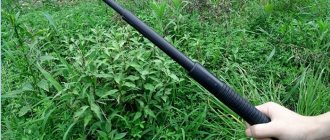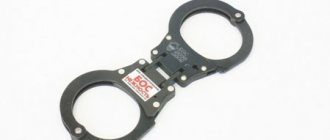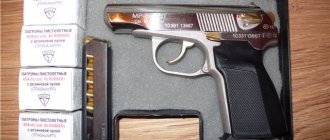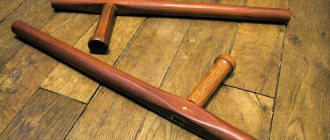Often, those who are called upon to maintain order themselves become the target of attack. With the increase in crime, such cases have become more frequent in relation to employees of the police department and the penal system. To resist intruders, employees of security companies, the penitentiary system and the police are equipped with such an effective special tool as a stick. The modern rubber model of this weapon, which today can often be seen in the hands of security and law enforcement agencies, has its own history dating back to 1881.
The first special equipment of the 19th-20th centuries
In 1881, the lower ranks of the St. Petersburg police used checkers to restore order. On May 20 of the same year, the Minister of Internal Affairs, in a report “On the armament of the lower ranks of the St. Petersburg police,” voiced a request to replace dragoon sabers with wooden sticks.
At this time, the baton was widely used in police forces in France and England. Adopting the experience of the city police of these states, Tsarist Russia gave preference to stacks, which in their purpose and method of use are close to clubs. Stacks were used by cavalrymen both to restore order and to control the horse.
Soon checkers were replaced, but not by sticks, but by army sabers, which provided protection for the hands. In Russia, the issue of introducing wooden sticks was not resolved until 1917. Historians explain this by the excessive activity and self-arming of the masses, characteristic of pre-revolutionary times. To pacify the rioters, the authorities used army units, which were well armed and did not need sticks.
PR-73: description
Among the wide variety of special equipment, the rubber stick-73 has gained particular popularity since 1973. It is a product consisting of:
- From the holder - a comfortable and rigid handle.
- A lanyard, or leather loop, necessary for fixing and relaxing the hand. This makes it possible to carry out striking and defensive actions. The chrome-tanned loop is made of nylon or leather. The width is 10 mm. An acceptable length allows you to adjust the loop according to your hand.
- A flexible striking element, due to which this stick, unlike a regular one, when swinging, receives additional acceleration in the last phase of the impact. In this case, a gain is achieved in both speed and strength.
- The rubber stick weighs 73 g.
- Size: 650 mm.
- Diameter: 32 mm.
Device structure
An elastic and rather long baton is cast from rubber mass in a mold using vulcanization. Inside there is an embedded element that increases elasticity. The handle is quite rigid and dense, there are holes in it where a lanyard is inserted - a loop of nylon or leather one centimeter wide. The loop can be adjusted according to your hand.
To carry a rubber stick on a belt, there is a special device made of belts with a fastening ring.
They carry a baton on the side opposite the firearm.
The video below shows the use of a rubber stick PR 73, which received positive reviews from employees of the Ministry of Internal Affairs:
In what situations is it used?
The PR-73 rubber stick is used:
- In prisons and pre-trial detention centers. In order to prevent an attack, employees of the penitentiary system have the right to use this special means in relation to suspects, accused and convicted persons. Hitting with a rubber truncheon is legalized during mass riots and group violations of the regime by persons under investigation and convicts. The use of special means is allowed in cases of disobedience to correctional officers and attempts to escape.
- To prevent escape when escorting a detainee, suspect or convicted person.
- When the hostages are released.
- During the dispersal of protesters at unauthorized rallies.
- During the assault by law enforcement special forces on buildings and vehicles.
The advantage of rubber sticks is the absence of serious injuries on the human body after using this special equipment. This is possible in cases where the use of PR meets all the requirements established by law.
Review of the baton (rubber stick) PR 73
Advantages and disadvantages
Pros:
- The item is not classified as a bladed weapon and is available for free sale.
- The flexibility of the rubber and the embedded element, which increases elasticity, make the blows energetic and effective.
- This weapon is not lethal (unless, of course, you hit in prohibited places). Therefore, if you defend yourself, you will not have to pay with a prison sentence.
Minuses:
- Quite a long length, considerable weight, which does not allow you to carry the baton with you hidden.
- It is not always possible to fight off an attacker, especially if he is not alone.
- Rigidity is not always sufficient, especially if there is a close street fight.
- If you carry the accessory with you, law enforcement agencies may be interested. The law does not fully answer the question of the legality of wearing.
An overview of the PR 73 baton is given in this video:
Purpose
This product is in service with law enforcement officials, as well as pre-trial detention centers, prisons and colonies, and employees of detective agencies.
- The baton is designed to protect in a humane way (without the use of firearms), as well as to pacify unauthorized rallies, gatherings, demonstrations, pickets.
- A rubber stick can also be used by ordinary people (for example, car owners) for self-defense.
Rubber stick PR 73M (photo)
Varieties
In addition to the basic model, which came into circulation in 1973 (which is why the product is marked with the number 73), there is also a model PR 73M (modified). It is a little thinner, lighter and longer.
The characteristics of both models (rubber stick PR 73 and PR 73M) are given below.
In what position should the PR-73 be used?
The effectiveness of using a rubber stick depends on the correct stance during a conflict. It is better to carry out attacking actions, counterattacks, and changes in distance in a combat stance. It can be right- or left-sided. For right-handers, instructors recommend left-handed. The main thing is that nothing impedes movement. The rubber stick can be held in one hand, or with both hands at both ends. Reflecting an attack from the front is performed in a side stance: the PR-73 is held with both hands, and the body, with the feet in the same position, is turned to the side.
Allowable hits
In the Russian Federation, a rubber stick PR-73 can be used to deliver swinging blows to the torso and limbs from above, below and from the side. Poke strikes are also legalized. It is forbidden to hit the head, neck, genitals and collarbone. First of all, law enforcement officers have the right to hit people on the wrist, since attackers mainly resist using knives. In the hands of a person who has undergone special training, a missile launcher is considered a dangerous weapon that can cause serious damage. In order for the work with a rubber truncheon to be both effective and not have serious consequences for the detainee, each operational police officer must have information about the most vulnerable points on the human body. You also need to know about the possible consequences after impacts.
RUBBER STICKS IN SECURITY ACTIVITY: TYPES, APPLICATION, LIMITATIONS
- General description of the rubber baton
- History of the police baton
- Types of rubber sticks
- Application requirements
- Using a rubber stick
The carrying and use of rubber truncheons by private security service employees has become a common occurrence for us today.
At the same time, not all Russian citizens have an accurate idea of the exact purpose of this special security equipment and its types. Also, few people have detailed information about the possibilities of using rubber batons by security guards and police officers and the legislative framework that regulates this area. Our article provides a detailed description of a rubber stick as a special security device. Its main types and legal norms governing the use of a police baton are noted here. The review also describes some techniques for effectively using a rubber stick as a weapon of self-defense. All information was provided by employees of Private Security Company LEGIS, who have professional training and extensive experience in the use of rubber sticks and tonfas when providing security services in Moscow, St. Petersburg and Krasnodar. RUBBER STICK FOR GUARD: GENERAL DESCRIPTION
A rubber stick (baton) is a special security device used for active defense. According to the legislation of the Russian Federation, it is included in the ammunition of police officers and private security guards. Rubber batons are used for self-defense when repelling an attack, as well as when detaining an intruder who offers physical resistance.
The structure of the rubber baton is a molded rod made by vulcanization. At one end there is a handle with a lanyard. Some models of the rubber stick use an additional perpendicular handle. This variety is designed in the likeness of the tonfa, a traditional bladed weapon used in martial arts.
Rubber sticks, like other special security equipment (for example, handcuffs) are an integral part of ammunition. Therefore, special hard cases or rings attached to the belt are used to carry them. You can obtain more detailed information on the characteristics of rubber batons from our specialists by filling out an application for the provision of security services.
RUBBER STICK FOR SECURITY: SOME HISTORICAL FACTS
The use of rubber sticks in private security activities in Russia was introduced in 1992. However, the first attempts to introduce such special equipment into the practice of security agencies were made much earlier. In 1881, the Minister of the Ministry of Internal Affairs, Ignatiev, turned to the emperor for permission to arm the police with wooden clubs, which were already in use at that time in a number of European countries.
If at that time the refusal occurred due to the ruler’s great humanity, then on the eve of the 1917 revolution the emperor refused a new appeal for a different reason. This time, police batons turned out to be inappropriate, since more effective weapons had to be used to pacify the riots. Attempts were repeated several times during the USSR. However, under the totalitarian Stalinist regime there was no such need. Therefore, it was only in 1962 that a resolution was adopted on the wearing of rubber truncheons by police officers.
For security guards of private services, such permission was given in 1992. For more than a quarter of a century, legislation in this area has changed significantly. At the same time, the main one here was and remains the Federal Law “On private detective and security activities in the Russian Federation” with numerous amendments. This document regulates the use of rubber batons, and also determines the types of this special equipment permitted for use by private security guards.
TYPES OF RUBBER STICKS IN MODERN SECURITY ACTIVITIES
The current legislation of the Russian Federation establishes the following types of rubber sticks permitted for use by employees of private security services and organizations:
- PR-73 is a universal model of straight shape and with standards of 700 mm/30 mm/700 g (length/diameter/weight). In recent years, a modified PR-73M rubber baton, equipped with a ring protrusion (mini-guard) on the handle, is more often used.
- PR-K (PR-CONTACT) is a shortened straight model with parameters 465/31/600. The model is considered more convenient when used in cramped conditions, where the risk of injury to third parties increases.
- PR-T (PR-TARAN) - a rubber stick with a side handle and technical characteristics 565/30/750. This tonfa is extremely comfortable to use and wear. In addition, the impressive size of the PR-T produces a deterrent effect.
- PUS-1 “ARGUMENT” is a special universal stick, manufactured in lengths of 480 or 650 mm. The design feature of this model is the presence of a plastic shield that protects the hand.
- PUS-2 "ARGUMENT-M" / "ARGUMENT-B" - an analogue of PUS-1, equipped with an additional perpendicular handle. This model of a rubber stick significantly increases the advantage of security officers over attackers or detainees.
- PUS-3 “ARGUMENT” is a universal telescopic rubber stick that provides maximum wearing comfort. The length of the model when folded is 300 mm, and when working it is 600 mm.
The choice of a suitable model depends on the specifics of the security services provided by private security company employees.
LEGAL REGULATION OF THE USE OF RUBBER STICKS
Currently, the wearing and use of rubber police batons is permitted for private security personnel who have undergone appropriate training and have a 4, 5 or 6 rank security guard. The use of this category of special security equipment is permitted when repelling an attack that directly threatens the life and health of a security guard. Also, a security guard’s rubber stick is acceptable for use in cases where violators resist arrest.
The law stipulates that the use of such special equipment as a rubber truncheon is permissible only in situations where non-violent methods (prevention) have failed. At the same time, hitting with a rubber truncheon by a security guard is prohibited against women with visible signs of pregnancy, disabled people and minors. The only exceptions here can be those cases when the attacker or detainee offers armed resistance, as well as in cases of a group attack on a security officer.
EFFECTIVE PROTECTION TECHNIQUES WITH A RUBBER STICK
To use a rubber baton as a weapon of self-defense, security guards undergo special training. Its task is to effectively use the advantages of this special tool. They are based on swinging strikes to the limbs of attackers or detainees in combination with the correct movement of a security officer. Practice shows that the most favorable situations in which to strike with a rubber stick are the following:
the enemy clearly intends to attack and does not expect a counterattack; the offender tries to remove a weapon or other dangerous object from his clothing; the attacker's armed hand is in a disadvantageous position for his attack; the person being detained or the attacker makes a swing. Trained guards take into account the inertia of the rubber stick, the ability to maneuver when using it, as well as other important features.
To place an order for the provision of security services in Moscow, St. Petersburg and Krasnodar, you can order a call back from our specialist.
Points of the second group
These include places on the human body, impacts to which are fraught with serious consequences or lead to death:
- Temporal region of the head, eyes, bridge of the nose and neck. The impact results in loss of vision, unconsciousness or death.
- Ear. May cause hearing loss and head injuries.
- Kidneys. Impacts to this place are fraught with rupture of internal organs.
A rubber stick is considered a very effective tool, and in skillful hands it is only slightly inferior to a firearm. This should be taken into account, since abuse of power, according to the legislation of the Russian Federation, entails serious liability.
Clubs, Bits, Fly swatters
The club, along with the stone, is the most ancient weapon that has accompanied man since the Stone Age. Having come a long way, they are still used by the police and for self-defense. These means are designed to inflict damage to the enemy’s limbs, hold and completely control his body movements, as well as protect one’s own body from blows from third-party objects.
Rubber baton or stick of approved hardness
This is one of the types of contact means of self-defense. While rubber batons used by employees of the Ministry of Internal Affairs, according to Art. 2 of the “Weapons Law” refer to cold, crushing weapons, and therefore the civil circulation of such weapons is prohibited; the batons we offer are not such. They are not subject to mandatory certification and, in accordance with TU2536-001-10648860-2006, are manufactured without reinforcing elements in the working part, as a result of which they do not have an impact-crushing effect and are not subject to the ban.
Sports equipment for defense
The tradition of transporting wooden baseball bats by drivers in their cars is especially strongly cultivated. In second place is the idea of storing bits near the entrance to the apartment in case of uninvited guests. It is worth understanding that the force of a blow using a bat will be significantly higher than a knockout from a professional boxer. Therefore, we recommend the use of this product only for playing with a sword for sporting purposes. From the point of view of the law, a baseball bat is a sports equipment for hitting the ball in baseball. The main reason for seizure by police officers is the suspicion that a crime was committed with the help of this item and must be documented.
Heavy Duty Flashlight Bat
The bit in the “Lantern” form factor refers to GOST 4677-82, just like an ordinary small flashlight. The products are made of anodized aluminum that is non-corrosive. Thanks to its solid body and increased weight, the flashlight bat allows you to strike with great force with less effort. The main purpose of this product is a powerful and highly targeted stream of light. When purchasing a flashlight-bat, you should immediately abandon Chinese conversions into a stun gun, which are prohibited for civilian use. It comes with a CORDURA bag made in the shape of a baton. The wide part is filled with lead shot, and can be filled with any weighting material (metal coins, keys, etc.) on the narrow part, which protrudes in the shape of a handle, there is a wrist loop for a more secure hold.
Fly swatters for hunting and fishing
It is a bag made in the shape of a baton. The wide part is filled with lead shot, and can be filled with any weighting material (metal coins, keys, etc.) on the narrow part, which protrudes in the shape of a handle, there is a wrist loop for a more secure hold. A fly swatter can be used when hunting, to stun wild animals, when fishing to stun fish, and of course as a legal means of self-defense.
Modern rubber sticks: types
1. PRS. The special equipment is intended for employees of the Ministry of Internal Affairs and other law enforcement agencies. The kit includes special leather holders that allow you to carry batons on your waist belts.
- Product size - from 450 to 580 mm.
- Diameter - 3 cm.
- Weight - 630 g.
2. PR-73M. The handles of these rubber sticks are equipped with annular protrusions that serve as a guard - protecting the fingers from glancing blows from the enemy. The protrusion is used as a stop for carrying this special equipment in hard cases on the belt.
- The product size is 700 mm.
- Diameter – 3 cm.
- Weight – 700 g.
3. PR-K (rubber stick “Contract”). The design of this special equipment is similar to the PR-73M. The differences are in the parameters:
- Stick size – 465 mm.
- Diameter – 31 mm.
- Weight – 600 g.
4. PR-T (“Taran”). The product is represented by a cast rubber rod with a round cross-section. At one end of the rubber stick (in the area of the handle) there is a lanyard, and at the other there is a hemispherical striking part. The design of this special tool provides an additional handle with a stop (115 mm), which is located at a right angle in relation to the striking part.
- Product length – 565 mm.
- The impact part has a size of up to 40 cm.
- Diameter – 30 mm.
- Weight – 750 g.
Specifications
| Name | Meaning | Units |
| Manufacturing method | casting | |
| Material of manufacture | rubber | |
| Model PR 73: | ||
| Diameter | 32 | mm |
| Weight | 730 | G |
| Length | 650 | mm |
| Model PR 73M: | ||
| Diameter | 30 | mm |
| Weight | 700 | G |
| Length | 700 | mm |
Universal special equipment “Argument”
1. PUS-1. The product belongs to special universal rubber sticks. Polymer synthetic materials are used in production. A lanyard is attached to the grooved handle. In order to prevent hand injuries, the developers have included a plastic shield in the design of this rubber stick. This PR can be worn on the belt using a special belt ring.
- The product size is 66 cm.
- Diameter 32 mm.
- Ring diameter – 4 cm.
- Lanyard diameter – 8 mm.
2. PUS-2. This product is identical to the first model of the universal special tool. The difference is that the PUS-2 design has an additional handle, which allows the guard to deliver swinging blows to the hands and at the same time maintain a distance from the enemy, not giving him the opportunity to grab and strike.
- The length of the gun in the folded position is 48 cm.
- The unfolded stick measures 65 cm.
3. PUS-3. Special universal rubber stick. The characteristics of this product are identical to the previous two models. The differences are in size. The telescopic PUS-3 when folded has a length of 30 cm, and after unfolding it is 48 cm. Rubber tips for sticks are designed for delivering sudden and pre-emptive strikes.
Prices and reviews
A baton of this model costs from 500 rubles and more, a case for wearing on a belt will cost from 250 rubles.
- The accessory serves well for self-defense. It is advisable to direct the blows (with a pull) to where the skin is exposed. This makes it more painful.
- Carrying a long baton with you is not very convenient, but in a car it can be very useful.
- Law enforcement officers quite often show interest in baton owners. The outcome may vary. Permission may be required.
Rubber stick PR 73F
Strikes ahead. In what cases are they used?
Moments when a preemptive strike is most effective:
- During the attack. The attacker concentrates all his attention on his own action and at this time is not ready to attack the guard.
- At the moment when the attacker takes a knife, stick, broken bottle or other bladed weapon from his pocket.
- During the swing.
Before launching preemptive strikes, guards can negotiate, distract with their gaze, and perform other actions in order to lull the vigilance of the criminal. A pre-emptive strike is first applied to the hand holding the weapon in order to knock it out. The guards' instructions recommend a blow to immobilize a hand and temporarily disable it as an acceptable blow.
The official work of law enforcement officers and workers in the security business involves frequent clashes with the criminal element. The introduction of PR into the equipment of police and security guards, as well as training to increase the efficiency of using this special equipment, provides law enforcement officers with the opportunity to get out of conflict situations without casualties.








